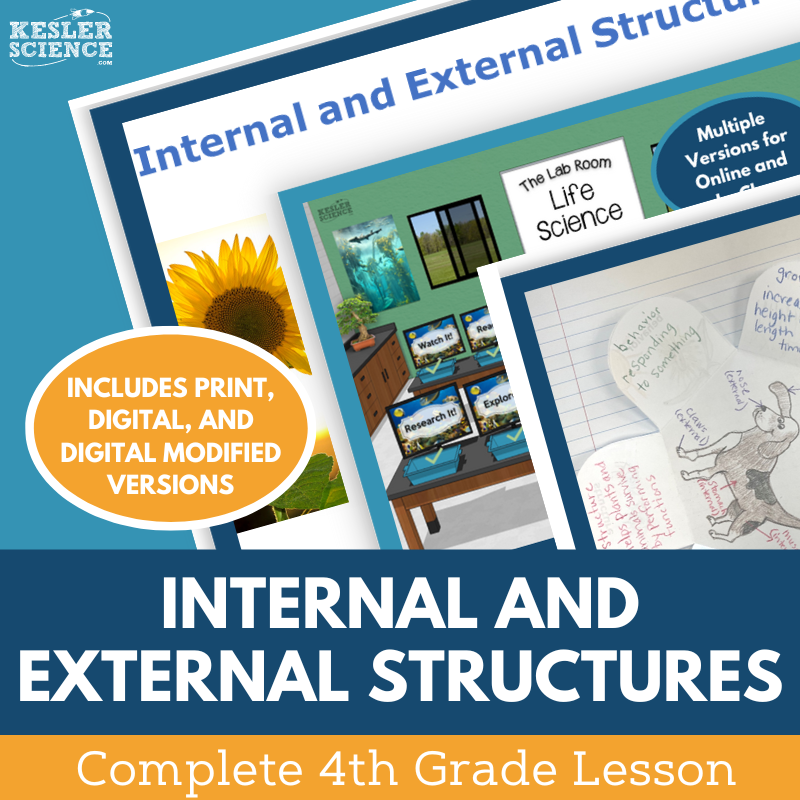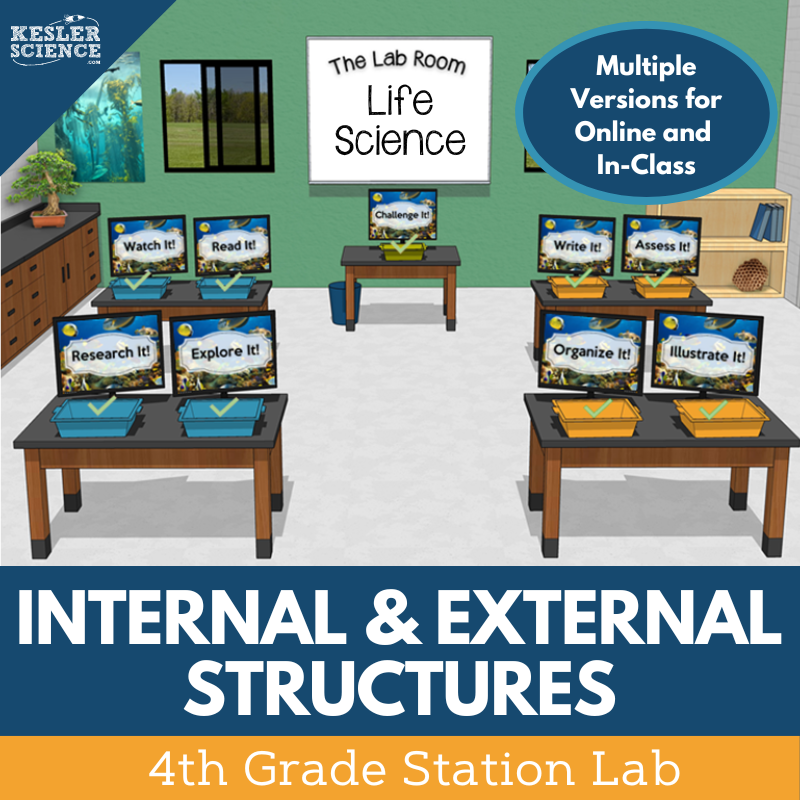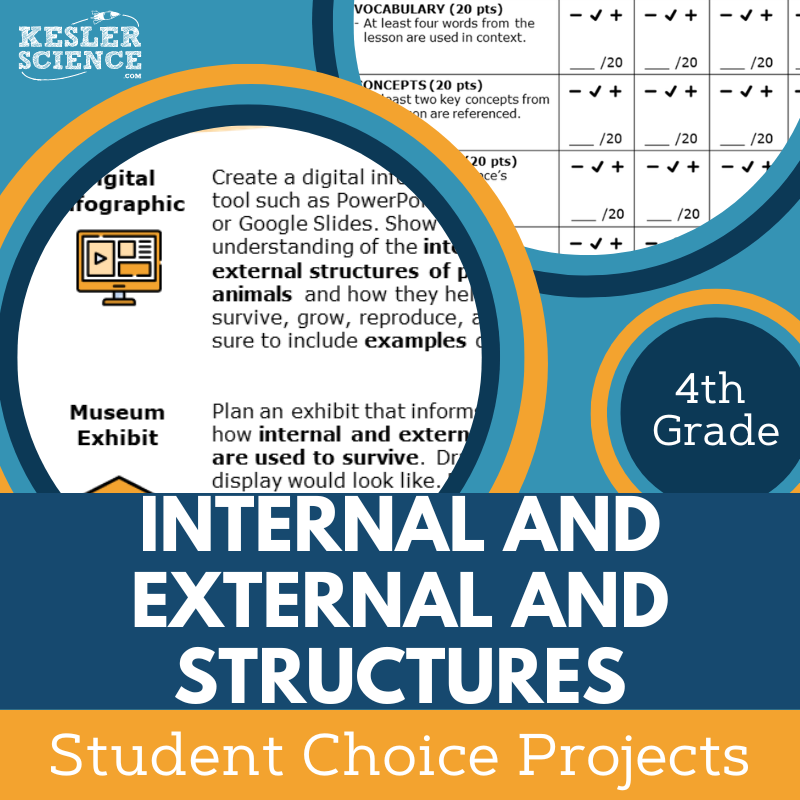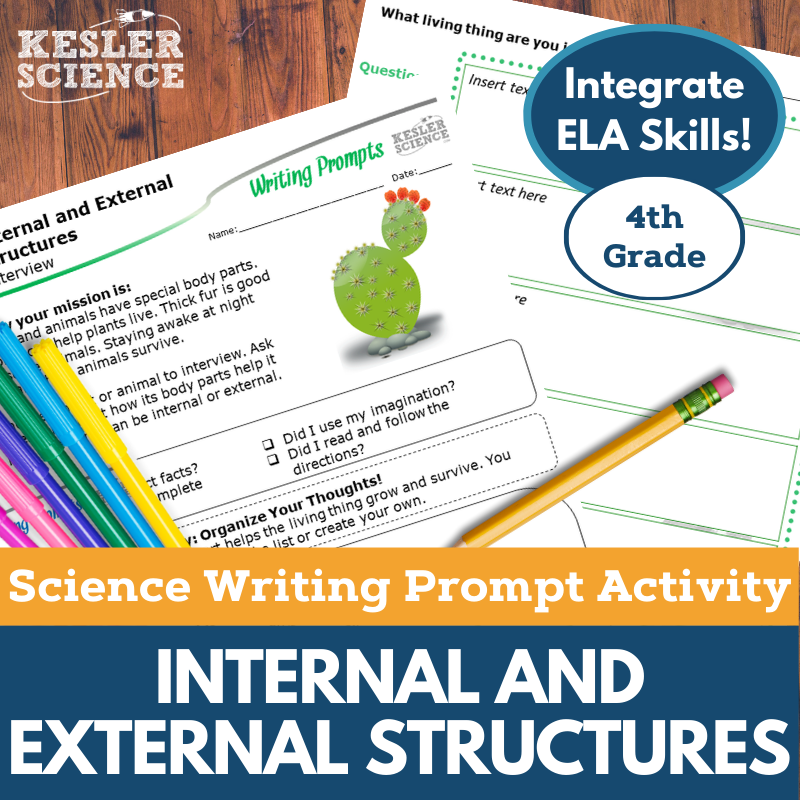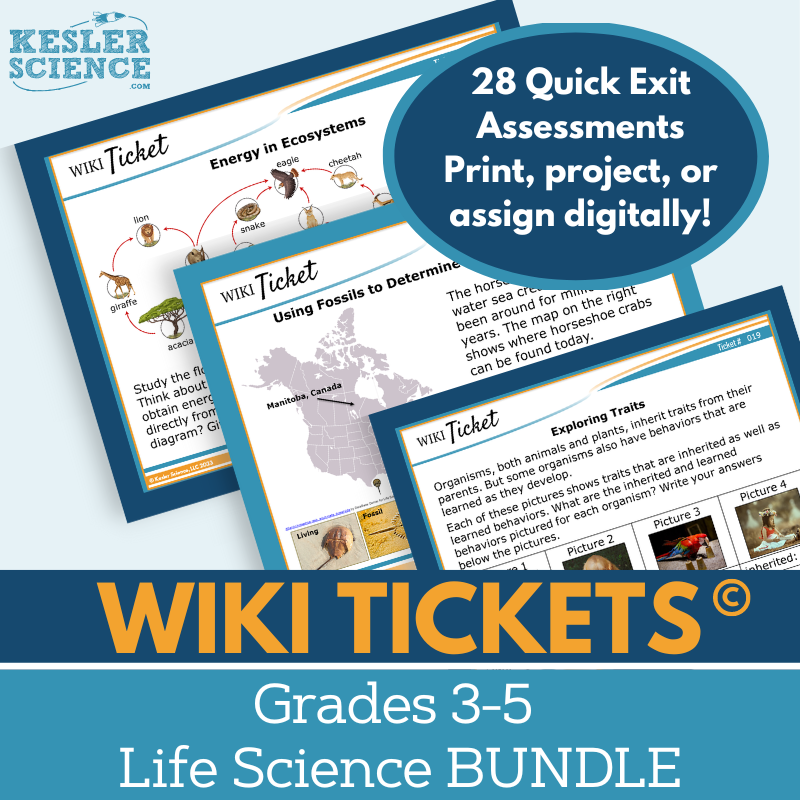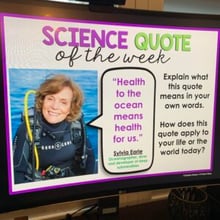Internal & External Structures Activities for 4th Grade Science
Students investigate how internal and external structures help plants and animals survive in this engaging 5E life science lesson. The resources below will give students a comprehensive understanding of internal and external structures. All of the following materials are also included in the Kesler Science Membership.
The Kesler Science Internal and External Structures 5E Lesson is a comprehensive life science unit designed for elementary students. This engaging, student-led lesson includes editable presentations, worksheets, choice projects, and assessments, requiring little to no prep. It aligns with NGSS 4-LS1-1 and the 2021 TEKS standard for Texas teachers.
Students explore how internal and external structures help plants and animals survive through a differentiated, multimodal approach. The lesson follows the 5E Model, beginning with engaging discussion activities and vocabulary support in English and Spanish. In the Exploration phase, a student-led station lab offers nine interactive stations, including hands-on experiments, reading comprehension, research, video discussions, card sorts, writing prompts, and drawing activities. A bonus station provides extension opportunities for early finishers.
Explanation materials include editable PowerPoints, interactive notebooks, and note-taking templates in digital and print formats. Elaboration involves student-choice projects, while Evaluation features STAAR 2.0-aligned assessments and review materials. This resource is flexible for both in-person and virtual learning, ensuring accessibility for all students.
The Kesler Science Internal and External Structures 5E Lesson is a comprehensive life science unit designed for elementary students. This engaging, student-led lesson includes editable presentations, worksheets, choice projects, and assessments, requiring little to no prep. It aligns with NGSS 4-LS1-1 and the 2021 TEKS standard for Texas teachers.
Students explore how internal and external structures help plants and animals survive through a differentiated, multimodal approach. The lesson follows the 5E Model, beginning with engaging discussion activities and vocabulary support in English and Spanish. In the Exploration phase, a student-led station lab offers nine interactive stations, including hands-on experiments, reading comprehension, research, video discussions, card sorts, writing prompts, and drawing activities. A bonus station provides extension opportunities for early finishers.
Explanation materials include editable PowerPoints, interactive notebooks, and note-taking templates in digital and print formats. Elaboration involves student-choice projects, while Evaluation features STAAR 2.0-aligned assessments and review materials. This resource is flexible for both in-person and virtual learning, ensuring accessibility for all students.
Engage your 4th-grade students in an interactive exploration of Internal and External Structures with this student-led station lab. Designed to promote active learning, this lesson guides students as they construct arguments about how plants and animals have structures that support survival, growth, behavior, and reproduction. With a modular approach, students take charge of their learning while teachers facilitate rather than direct instruction.
This station lab includes nine differentiated stations that allow students to explore concepts through a variety of engaging activities. Input stations introduce new information through experiments, research, readings, and videos, while output stations help students demonstrate their understanding through organizing, illustrating, writing, and assessments. A bonus challenge station offers extension activities for early finishers, providing opportunities for deeper learning through creative projects.
Students can work independently or in small groups, making this resource ideal for both in-class and virtual learning environments. With ready-to-use materials, including all necessary signage, literature, task cards, and differentiated passages in English and Spanish, this station lab ensures a seamless, engaging experience that enhances comprehension and critical thinking skills.
Engage your 4th-grade students in an interactive exploration of Internal and External Structures with this student-led station lab. Designed to promote active learning, this lesson guides students as they construct arguments about how plants and animals have structures that support survival, growth, behavior, and reproduction. With a modular approach, students take charge of their learning while teachers facilitate rather than direct instruction.
This station lab includes nine differentiated stations that allow students to explore concepts through a variety of engaging activities. Input stations introduce new information through experiments, research, readings, and videos, while output stations help students demonstrate their understanding through organizing, illustrating, writing, and assessments. A bonus challenge station offers extension activities for early finishers, providing opportunities for deeper learning through creative projects.
Students can work independently or in small groups, making this resource ideal for both in-class and virtual learning environments. With ready-to-use materials, including all necessary signage, literature, task cards, and differentiated passages in English and Spanish, this station lab ensures a seamless, engaging experience that enhances comprehension and critical thinking skills.
The Internal and External Structures Student Choice Projects allow 4th-grade students to demonstrate their understanding in a way that suits their preferred output style. A project page presents six student-led options plus a “design your own” project, with an editable rubric for teacher, peer, or self-assessment.
These flexible, multimodal projects support diverse learning needs. Two versions of the project page provide differentiation, with modified options for students needing remediation and challenge opportunities for advanced learners. Teachers can adjust the rubric to fit grading needs.
The projects require standard classroom supplies like paper, markers, and scissors, with many options available for digital completion. Some crafting materials may be helpful for model-building.
The Internal and External Structures Student Choice Projects allow 4th-grade students to demonstrate their understanding in a way that suits their preferred output style. A project page presents six student-led options plus a “design your own” project, with an editable rubric for teacher, peer, or self-assessment.
These flexible, multimodal projects support diverse learning needs. Two versions of the project page provide differentiation, with modified options for students needing remediation and challenge opportunities for advanced learners. Teachers can adjust the rubric to fit grading needs.
The projects require standard classroom supplies like paper, markers, and scissors, with many options available for digital completion. Some crafting materials may be helpful for model-building.
The Internal and External Structures science writing activity engages 4th-grade students in a fun, interview-style question-and-answer exercise to test their life science knowledge. Designed for both print and digital use, this activity enhances science reasoning and writing skills while supporting virtual and in-person learning.
Aligned with NGSS 4-LS1-1, this low-prep, student-centered resource includes teacher directions with an answer guide and rubrics, projection and print handouts, and a digital PowerPoint version for Google Slides. It can be used as a cross-curricular activity, pre-test assessment, student choice project, or enrichment for early finishers. Ideal for extra credit, make-up work, or differentiation, this writing prompt fosters engagement and science literacy, making it a valuable addition to any classroom.
The Internal and External Structures science writing activity engages 4th-grade students in a fun, interview-style question-and-answer exercise to test their life science knowledge. Designed for both print and digital use, this activity enhances science reasoning and writing skills while supporting virtual and in-person learning.
Aligned with NGSS 4-LS1-1, this low-prep, student-centered resource includes teacher directions with an answer guide and rubrics, projection and print handouts, and a digital PowerPoint version for Google Slides. It can be used as a cross-curricular activity, pre-test assessment, student choice project, or enrichment for early finishers. Ideal for extra credit, make-up work, or differentiation, this writing prompt fosters engagement and science literacy, making it a valuable addition to any classroom.
The WIKI Tickets© Life Science Set provides 28 engaging formative assessments for 3rd–5th grade science, available in five formats: a full-screen display for projection, three printable handout versions, and an interactive digital version compatible with PowerPoint and Google Slides. These assessments align with NGSS and TEKS standards, ensuring comprehensive coverage with at least one ticket per standard.
Designed for flexibility, WIKI Tickets© can be used in both in-person and virtual learning environments. Topics covered include animal groups for survival, changes in ecosystems, energy flow in food webs, inherited traits, internal and external structures, the senses, and more. A bonus table of contents file is included for easy alignment reference.
These colorful assessments serve as exit tickets, bellringers, or quick checks on student understanding. They can be projected for class discussion, printed for written responses, or assigned digitally for individual work. WIKI Tickets© provide a versatile, engaging way to gauge student progress in life science.
The WIKI Tickets© Life Science Set provides 28 engaging formative assessments for 3rd–5th grade science, available in five formats: a full-screen display for projection, three printable handout versions, and an interactive digital version compatible with PowerPoint and Google Slides. These assessments align with NGSS and TEKS standards, ensuring comprehensive coverage with at least one ticket per standard.
Designed for flexibility, WIKI Tickets© can be used in both in-person and virtual learning environments. Topics covered include animal groups for survival, changes in ecosystems, energy flow in food webs, inherited traits, internal and external structures, the senses, and more. A bonus table of contents file is included for easy alignment reference.
These colorful assessments serve as exit tickets, bellringers, or quick checks on student understanding. They can be projected for class discussion, printed for written responses, or assigned digitally for individual work. WIKI Tickets© provide a versatile, engaging way to gauge student progress in life science.
Year-Round Resources
These year-round activities will increase your students' understanding of many middle school science topics. All of these activities are also included in the Kesler Science Membership.
Visual Data & Graphing
You're not alone if your students struggle with understanding graphs, charts, and tables. It's a skill that takes an enormous amount of practice. This resource will help students build a strong foundation in analyzing data and creating their own data visualizations.
Bell Ringers and Warm-Ups
These middle school science bell ringers are an excellent way to engage your students as soon as they walk into your classroom. This comprehensive FULL YEAR resource includes everything you need to start off each science class with an interesting warm-up activity.
Review Board Games
Each game board has been carefully designed to keep students engaged. There are 10 different action spaces on each board and dozens of question cards. All of the actions are related to science concepts and keep the students motivated throughout the game.
Each game is ready to play. Simply print out the board and the cards and let the students enjoy reviewing nine different units.
Essential Questions and Standards
Below are the essential questions and standards associated with the lessons and activities included in the internal and external structures unit. This topic is only one of more than 100 middle school science topics included in the Kesler Science Membership.
-
What are some of the internal and external structures of plants that help them survive?
-
What are some of the internal and external structures of animals that help them survive?
-
NGSS - 4-LS1-1 Internal & External Structures
Kesler Science Membership
Imagine never having to search for another middle school science lesson again. The membership gives you access to ALL of the Kesler Science products in one place (Yes, including everything above).
Say goodbye to long hours of lesson prep.

